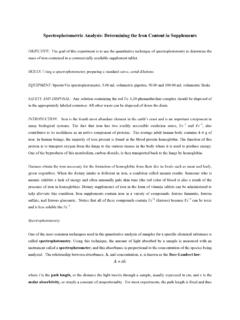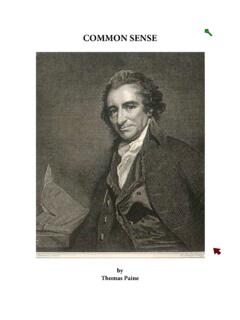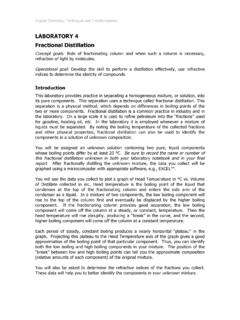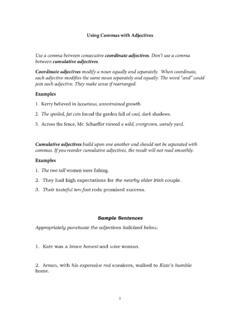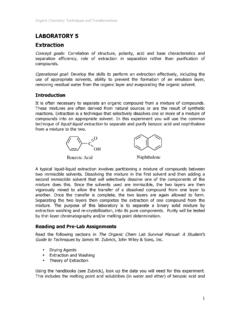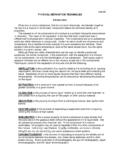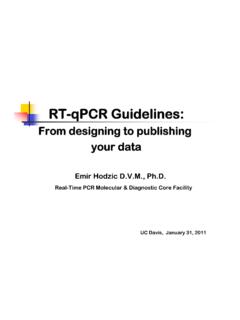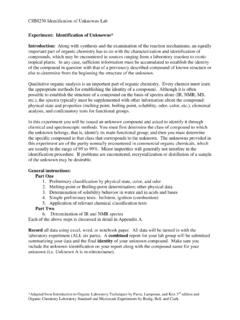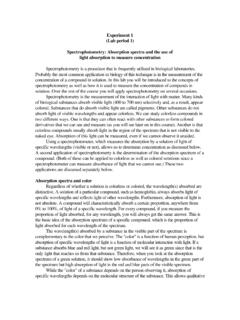Transcription of LABORATORY 1 Melting Points and Mixture Melting Points
1 Organic Chemistry: Techniques and Transformations 1 LABORATORY 1 Melting Points and Mixture Melting Points Concept goals: Correlation of Melting point range with structure and purity of a compound. Operational goal: Develop the skills to take the Melting point of a compound effectively, including proper packing of a sample in a Melting point capillary tube, precise determination of the Melting point range of a sample. Introduction In this LABORATORY you will identify an unknown compound by using Mixture Melting Points . The Melting point of a compound is the temperature at which the solid phase and liquid phase are in equilibrium. It is one of the characteristic physical properties of a compound like boiling point, density, and refractive index. A pure compound will typically melt over a very narrow range of temperatures, usually 1 C or less. An impure compound typically melts at a lower temperature and over a broader range of temperatures.
2 Therefore, taking a Melting point can aid in identifying an organic compound and assessing its purity. In this experiment , you will be supplied with a small sample of a pure organic compound. Be sure to record the name or number of this Melting point unknown in both your LABORATORY notebook and your final report. Your sample will be one of the compounds listed in Table A Mixture Melting point is useful in determining the identity of your unknown compound. A small portion of a known compound, whose Melting point is known, is mixed with the unknown compound. If the Melting point of the Mixture is the same as that of the known compound, then the known and the unknown are most likely identical. A decrease in Melting point of the Mixture and a broadening of the Melting point range indicates that the compounds are different. Reading and Pre-Lab Assignments Read the following sections in The Organic Chem Lab Survival Manual: A Student s Guide to Techniques by James W.
3 Zubrick, John Wiley & Sons, Inc. The Melting Point experiment . See especially The Thomas-Hoover Apparatus, Before you come to the LABORATORY , do the Pre-Lab assignments for this LABORATORY as assigned by your instructor. Prepare your LABORATORY notebook as required by your instructor. Organic Chemistry: Techniques and Transformations 2 Procedure Read the assignments in the Reading section above. We will be using the Thomas-Hoover apparatus for this experiment , so read this section carefully. Part A Approximate Melting Point of Unknown Compound Place 2-3 mg of your unknown on a clean, dry watch glass. If the compound is not a fine powder, crush it with a spatula. Load a Melting point capillary by pushing the open end of the tube into the powder. Pack the powder into the closed end of the tube by tapping the closed end against the bench top or dropping the tube through a 2-3 long piece of glass tubing.
4 Make certain that there is no more than 1-2 mm of the powder at the bottom of the tube. A larger amount will give you a Melting point range that is too large. Insert the tube into a Thomas-Hoover apparatus and determine the approximate Melting point. Capillary tubes can easily break off in any Melting point apparatus, exercise care when inserting and removing tubes to avoid breakage. A heating rate of 3-4 C per minute should give you an approximate Melting point range that corresponds to one of the pairs of compounds in Table Record the temperature at which liquid first appears in the bulk of the sample and the temperature at which the entire sample become liquid. Be sure to record the name or number of this Melting point unknown in both your LABORATORY notebook and in your final report. While this may seem obvious, 20% of students regularly do not include this information in their lab report making the entire exercise worthless.
5 It is also helpful to record the number of the Thomas-Hoover apparatus you used. Thermometers differ in accuracy and occasionally the results from one apparatus will seem different from the others. Part B Identification of Unknown Compound by Mixture Melting Point Next, you will determine the exact identity of your unknown compound by measuring two Mixture Melting Points . From table 1, identify the two compounds that have Melting Points closest to the Melting point of your unknown compound. Label two clean, dry watch glasses with the names of these two compounds. Place 2-3 mg of one of the known compounds on the watch glass labeled with its name. Add an approximately equal amount of your unknown compound. Likewise, place 2-3 mg of the other known compound on the other watch glass and add an approximately equal amount of your unknown compound. Crush and mix each sample thoroughly with a clean, dry spatula.
6 Make sure to clean the spatula between samples. Load the samples into separate labeled capillary tubes. (Capillary tubes can be labeled by drawing horizontal lines near the top of the tube with a marking pen.) Take the Melting point of the two mixtures simultaneously. Quickly heat the samples to within 30 C of the approximate Melting point you measured earlier. Then slow the heating rate increase to 1-2 C per minute. Record the Melting point range for each Mixture and identify your unknown compound. Organic Chemistry: Techniques and Transformations 3 Follow your instructor s guidelines for a LABORATORY report and be certain that your report includes (1) the number or letter of your unknown compound, (2) your measured Melting point range for your unknown compound, (3) the compound names and Melting ranges for your Mixture Melting experiments and (4) the name, structure, and Melting point range of the known compound that most clearly agrees with your measured Melting point.
7 Table Melting Point Knowns Compound Literature mp ( C) A biphenyl 69-72 2,5-dimethyl phenol 68-71 B 1-chloro-4-nitrobenzene 83-84 4-hydroxy-3-methoxy benzaldehyde 81-83 C m-toluamide 94-96 Methyl-4-nitro benzoate 94-96 D phenanthrene 99-101 o-toluic acid 103-105 E acetanilide 113-115 fluorene 114-116 F benzoic acid 122-123 trans-stilbene 122-123 G cinnamic acid urea Results, Discussion and Conclusion Write your results, discussion of results and your conclusion. Complete any post-lab questions. Abstract This part should be filled in after the completion of the experiment and analysis of all data. When submitting the report, the abstract should appear at the beginning of the report. Report Adhere to the format required by your instructor and submit the report on time. Organic Chemistry: Techniques and Transformations 4 Summary 1. The Melting point of a compound is the temperature range at which a solid transforms into a liquid (the temperature at which the first drop of liquid appears until the temperature when all of solid is converted to the liquid).
8 2. Impurities lower and broaden the Melting point range of a sample. 3. Given an unknown compound, you should be able to determine its purity or identity by doing Mixture Melting Points with standard samples. Questions 1. In the following table, you will find the name, observed Melting point and literature Melting Points of several substances. Based on these data, what would you say about the purity of these substances? a) Naphthalene? b) p-anisic acid? c) 3-chlorobenzoic acid? d) Ferrocene 2. Ibuprofen has a literature Melting point of 75-77 C. A student carried out a synthesis in which she hoped to obtain ibuprofen. She isolated a product having a Melting range of 75-77 C. a) Explain why this information does not prove that her sample was ibuprofen. b) Using only the techniques of Melting Points , how could she prove that she had ibuprofen? 3. The Melting point of a pure compound is a unique property of that compound, independent of its source.
9 Is this statement true or false? Explain your reasoning. 4. No two pure compounds can have the same Melting point. Is this statement true or false? Explain your reasoning. 5. Explain why is it important to pack the capillary well when determining the Melting point of the samples. 6. A student was given an unknown compound X, which is one of the four compounds listed below. Phenyl succinate 121 oC O-toluic acid 102 oC m- aminophenol 122 oC benzoic acid 122 oC Substance Observed Melting Point (oC) Literature Melting Point (oC) Naphthalene 79-80 p-anisic acid 178-182 184 3-chloro benzoic acid 157-158 158 Ferrocene Organic Chemistry: Techniques and Transformations 5 A Mixture of X with benzoic acid melts at 92 oC, a Mixture of X with phenyl succinate melts at 120 oC and a Mixture of X with m-amino phenol melts at 102 oC. The student wrote that the unknown compound is O-toluic acid.
10 Was the student right? Explain your reasoning and provide an alternate explanation if the student is wrong.
